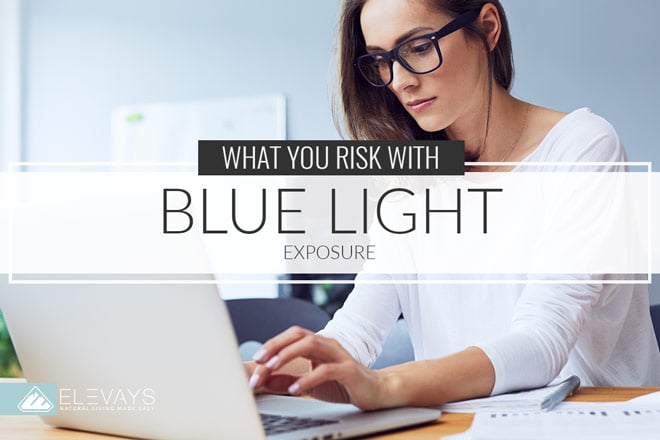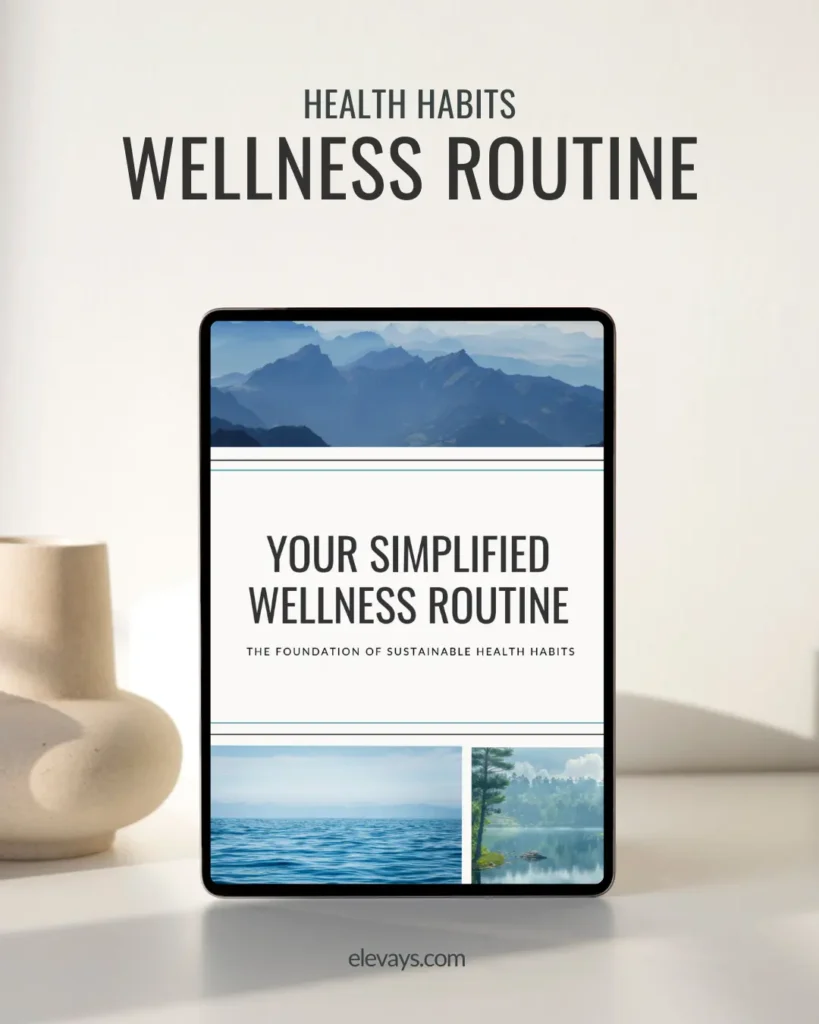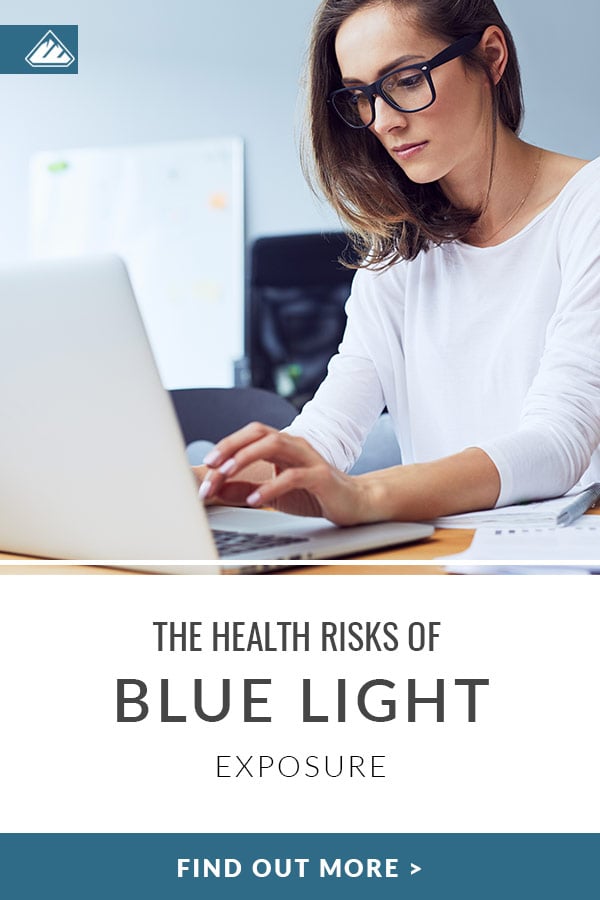Technological devices are widely available, taking up most of our daily attention. They make life easier and more fun at times, but the digital age has also increased risks of blue light exposure and its harmful effects.
Kids today are at an even higher risk. They become comfortable using digital devices at a young age, and they have more digital tools available to them than previous generations.
But you can protect your children from the damaging risks of blue light exposure.
TRUTH BOMB:
You’re
Already killing it!
If You Were More Consistent With Your Wellness Routine, You’d Be Unstoppable.
In this article, we’ll talk about what blue light is and exactly where you can find synthetic forms. Use this information to help you limit and reduce your family’s likelihood of adverse health effects from blue light.
What is Blue Light?
A standard blue light definition explains how sunlight consists of wavelengths of varying colors that combine to produce the white light we can view (1). The visible light spectrum, or the colors we can see with the human eye, travels in waves. Each color has a different effect, and each wave emits differing lengths, strengths, and energy. All the colors vary based on the wavelength and amount of energy they produce, where the shorter distance results in a higher power.
Blue light is one of the colors on this spectrum, and it collides with other molecules in the air to scatter anywhere the sun travels. It’s what makes the sky appear blue, and it comes in synthetic forms of light produced by electronics. Blue light, however, has an extremely short wavelength and tons of energy, which studies show can create long-term damage over time.
Unlike the sun’s harmful UV rays, blue light is visible by the naked eye, and it’s everywhere. For this reason, more people are concerned about protecting themselves from damage.
How are Humans Exposed to Blue Light?
You may not always notice blue light. But it’s everywhere.
Although the largest source of blue light exposure comes from sunlight, small amounts of blue light are in everyday technological devices. The light travels anywhere the sun can throughout the day and follows you inside at night through your digital screens and LED home lighting.
And even if you don’t notice a blue color on your screen, electronic devices almost entirely use blue light. Lights that often appear white contain blue light components, which expose human eyes to more blue wavelengths than they seem.
Most humans are exposed to blue light from using technology, as more people spend their waking hours in front of a digital screen. Studies show over 80% of American adults use a digital device for more than 2 hours per day, and nearly 59% reported using more than one device at a time (4).
You’ve been exposed to artificial blue light if you use (1):
- LED lights
- Energy-efficient fluorescent lights
- Compact Fluorescent Light (CFL) bulbs
- Flat-screen LED TVs
- Devices like tablets, smartphones, and computer monitors
How Does Blue Light Affect People?
Blue light affects people in varying ways. As with most things in life, there are positive and negative benefits involved.
These are high energy visible wavelengths, so they can flicker, create glares, lower contrast, and alter the clarity and sharpness of what you see. When humans view blue light, it passes through the eye cornea and lens before reaching the retina. Our eyes don’t filter out the blue light rays. Thus, the flickering is one of the main reasons for negative symptoms, such as:
- Eyestrain
- Headaches
- Fatigue (physical and mental)
Too much exposure can even prematurely damage the eyes, particularly in young children. With prolonged exposure, you can cause retinal damage that then contributes to age-related macular degeneration and vision loss.
Balance is critical, as a small amount of blue light is also necessary for optimal health. Blue light can:
- Boost alertness, memory, and cognitive function
- Increase mood and a feeling of well being
- Regulate circadian rhythm needed for better sleep (if exposed to small amounts during daytime hours only- while it can also throw circadian rhythm out of whack when it is nighttime)
- Improve the growth and development of vision in young people
However, blue light only has these benefits when you’re exposed to small amounts during daytime hours. Using devices with blue light in the evening can instead negatively affect sleep, circadian timing, and alertness (3).
Is Blue Light Exposure Bad For You?
In excess, yes. Too much blue light exposure particularly comes from long-term use and proximity to our screens. We use technology all day, every day. And a recent study found that the adverse effects of blue light from devices affect children more than adults (2).
However, too little blue light exposure also has adverse health effects on kids. If kids aren’t exposed to enough sunlight, for example, they may develop a deficiency in blue light. Studies show this deficiency can contribute to nearsightedness (3).
Health Risks Associated with Blue Light
While you need some blue light exposure for optimal health, the amount of artificial exposure most people receive is over the top. The harmful effects of overuse well outweigh the benefits in today’s world. Eyestrain is the most common negative effect people suffer from daily, but the blue light can also cause long-term harm such as:
- Blurry vision
- Headaches
- Neck and back pain
- Depression
- Permanent eye damage
- Vision loss
- Sleep interruptions
- Greater risk of certain cancers
Researchers from Harvard linked blue light exposure at night to multiple cancers, mainly breast and prostate cancers, heart disease, diabetes, obesity, and depression (5). The risks are even more significant for adults who work the night shift, as 43% of jobs require prolonged use of a device. Researchers don’t yet understand why there are such detrimental health risks of blue light exposure at night. However, it’s known to alter our sleep patterns as well.
Blue Light Eye Damage
We all spend the majority of our days staring at a digital screen, whether for work, play, or relaxing. Digital eyestrain is a new term you may have heard people complain about their favorite gadgets. In fact, it’s more prevalent than any other computer-related syndrome today. Blue light eye damage, therefore, happens to everyone.
However, it’s also a wide-spread medical epidemic that affects all ages. The symptoms can affect your productivity and learning ability. Eye damage caused by a blue wavelength of light comes with long-term health risks as well.
Too much, and the risks of blue light exposure intensifies. The length of time spent looking at screens increases your likelihood of negative results, like:
- Digital eye strain – The blue light from digital devices and computer screens causes sore or irritated eyes. You might feel unable to focus or have dry, irritated eyes.
- Retina damage – Multiple studies show continues exposure to excessive blue light leads to damaged cells in the retina, which causes vision problems such as age-related macular degeneration.
- Vision loss – Serious damage may lead to total vision loss over time.
Permanent eye damage happens with excessive long-term exposure, and it can destroy your vision. Medical evidence suggests the light contributes to retina cell destruction, which can cause severe damage like age-related macular degeneration and lead to vision loss (6). Chronic exposure also increases the likelihood of:
- Retinal degenerative diseases
- Macular degenerations
- Glaucomas
Age also plays a role. Our eyes attempt to absorb the harmful blue light rays with melanin, our natural sunscreen, but adults over the age of 65 are more likely to lose melanin levels that protect them against eye damage. Kids are also at a higher risk of eye damage because their corneas and crystalline lenses don’t fully develop before the age of ten (6).
Today, it’s vital for parents to their children’s amount of limit screen time as much as it is to supervise what your kids do online. But as the studies show, we all must take precautions to limit the risks of blue light exposure.
The Effects of Blue Light on Sleep
The terrible part about blue light is that it also depletes your melatonin secretion, which tells your body when it’s time to sleep and wake. Lower melatonin levels lead to health problems and terrible sleep. Our eyes are sensitive to blue light, so people can have trouble falling and staying asleep or even feeling tired.
Chronic blue light exposure not only lowers your sleep hormone, but it can also disrupt your natural circadian rhythm (3). It’s your sleep pattern, and your circadian rhythm is especially vulnerable at night. Blue light stimulates us, so it keeps us awake even when we want to sleep. Over time, your body loses all sense of day and night.
Studies show consistently poor sleep is further linked to negative health like:
A bedtime routine where you limit using devices a few hours before bed helps many people gain a better night’s sleep, adults, and children included. It’s tough, but even a few minutes of blue light exposure just before sleeping can force you to remain awake longer. Find a device cut-off time that works for your family and unplug consistently.
Make sure also to limit the amount of blue light in your bedroom too. Many clocks or fans, for example, have digital displays that light up at night.
How to Reverse Blue Light Exposure and Limit Damage
If you’re wondering how to reverse blue light exposure in your home, there are several ways to protect your eyes. Limiting your exposure prevents further trouble as well.
The best way to limit your exposure is to stay off devices that emit blue light, such as computers and phones, particularly a few hours before bed. Take frequent breaks when working in front of a screen to rest your eyes and limit the amount of time you spend watching TV. You can also try the “20-20-20 rule,” where you shift your eyes to peer at an object 20 feet from you every 20 minutes for no less than 20 seconds.
If consistent blue light exposure is still a problem, take further measures to protect your health by using:
- Artificial tears – Eye drops can refresh your vision when they start to feel strained.
- Screen filters – Available for all your devices, screen filters decrease the blue light produced to keep the rays from reaching your retina.
- Computer glasses – Glasses with yellow-tinted lenses help at blocking blue light, and you can wear them while working on your devices to limit eye strain.
- Anti-reflective lenses – These lenses protect one step further! They lower the glare and boost contrast to help block blue light from both digital devices and the sun.
- Intraocular lenses – If you’ve had cataract surgery, you may have an intraocular (IOL) lens to protect your eye from ultraviolet lights, including some blue light.
New blue-light-blocking gadgets come out every day. We offer a range of options in our store, from blue light blocking glasses and night lights to alarm clocks without blue light.
Blue Light Protection Glasses
Amber-tinted options are blue light protection glasses, and wearing them while using your devices is an effective way to avoid night exposure or limit harmful daytime rays. Blue light glasses block all blue light, whether from the sun or an artificial source. We love to wear these glasses after dinner and while we wind down for the night.
Research shows people who wear blue light blocking glasses continue producing melatonin as usual, even if they’re using the device in a well-lit room (11). The dimmer light helps prevent harmful effects, and people see improvements in mental performance, mood, and sleep.
You can also protect yourself against all blue light sources, both indoors and out, with specialized lenses and no-glare features.
Additional Blue Light Hazard Blockers
Finally, there are a few programs you can use to block blue light hazards. A computer program called f.lux, for example, adjusts the brightness and color of your screen based on the time. It connects to your timezone and blocks blue light as soon as it gets dark outside. You can find apps like this to combat blue light phone effects too.
So now that you have the down low on blue light- were you shocked by any of the research? Let me know in the comments below!
Sources
- Prevent Blindness. (2019). Blue Light and Your Eyes. Retrieved from: https://www.preventblindness.org/blue-light-and-your-eyes
- American Optometric Association. Blue Light Impact in Children. Retrieved from: https://www.aoa.org/Documents/OptometryCares/Blue%20Light%20Impact%20in%20Children.pdf
- Chang, AM., et al. (2014). Evening use of light-emitting eReaders negatively affects sleep, circadian timing, and next-morning alertness. Retrieved from: https://www.ncbi.nlm.nih.gov/pubmed/25535358
- The Vision Council (2019). Digital Eye Strain. Retrieved from: https://www.thevisioncouncil.org/content/digital-eye-strain
- Harvard Medical School (2012). Blue light has a dark side. Retrieved from: https://www.health.harvard.edu/staying-healthy/blue-light-has-a-dark-side
- American Academy of Opthalmology (2017). Normal Vision Development in Children. Retrieved from: https://www.aao.org/eye-health/tips-prevention/children-vision-development
- Cappuccio, F.P., et al. (2011). Sleep duration predicts cardiovascular outcomes: a systematic review and meta-analysis of prospective studies. Retrieved from: https://www.ncbi.nlm.nih.gov/pubmed/21300732
- Cappuccio, F.P., et al. (2009). Quantity and quality of sleep and incidence of type 2 diabetes: a systematic review and meta-analysis. Retrieved from: https://www.ncbi.nlm.nih.gov/pubmed/19910503
- Alvaro, P.K., et al. (2013). A Systematic Review Assessing Bidirectionality between Sleep Disturbances, Anxiety, and Depression. Retrieved from: https://www.ncbi.nlm.nih.gov/pubmed/23814343
- Cappuccio, F.P., et al. (2008). Meta-Analysis of Short Sleep Duration and Obesity in Children and Adults. Retrieved from: https://www.ncbi.nlm.nih.gov/pmc/articles/PMC2398753/
- Burkhart, K. (2009). Amber lenses to block blue light and improve sleep: a randomized trial. Retrieved from: https://www.ncbi.nlm.nih.gov/pubmed/20030543






READ the Latest
Health Habits
Health Habits
Longevity
Longevity
One Comment